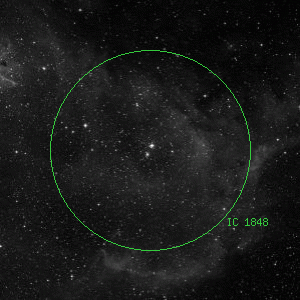IC 1848

Overlaid DSS image of IC 1848, 60' x 60' with north at top and west to the right
Aladin viewer for the region around IC 1848
| Type | Star Cloud |
|---|---|
| Magnitude | 6.5 |
| Size | 40' |
| Right Ascension | 2h 51' (2000) |
| Declination | 60° 24' N |
| Constellation | Cassiopeia |
| Description | Cl, star following, in F neby |
| Classification | IV 3 p n |
Observing Notes
Harold Corwin
IC 1848. The discovery of this cluster embedded in nebulosity was, like many of Barnard's "new" nebulae and clusters, sent directly to Dreyer (at least I can find no mention of it in Barnard's papers published before 1908). The IC description is unusual: "Cl, sts F, extends 8 [minutes] f, in F neby". The word that I have as "[minutes]" is printed in the IC as a superscript, lower-case "m" -- this implies that the extent of the cluster is about a degree.
This is, in fact, the case. This "cluster" comes from Plate 2 of Barnard's "Photographic Atlas of Selected Regions of the Milky Way". It is the obvious collection of stars in the middle of the plate, comprised of three clumps at roughly these positions (J2000), with roughly these sizes:Western clump: 02 51 32, +60 24.2; 30' x 23'These were estimated from DSSB2 images a degree across approximately centered on each clump, with reference to Barnard's Plate 2. The appearance is quite different on the red DSS2 plate: the fields become more dominated by nebulosity. The nebulosity disappears and the "clusters" become apparently larger and more scattered on the DSS2 IR plate, where they are defined by the surrounding obscuration rather than by any clumping of stars. The only exception is an apparently real cluster right around the two stars HD 17505 and HD 17520 -- this is the cluster noted by Brian Skiff.
Middle clump: 02 54 48, +60 38.1; 20' x 13'
Eastern clump: 02 58 39, +60 33.0; 26' x 19'
For the entire complex, I've taken a position (02 55, +60.0) and size (1.4 deg by 0.6 deg) from the DSS2B with reference to Barnard's Plate 2. Specifically, I've estimated the position on Barnard's plate, then found that position using a one-degree image displayed by SkyView. The size comes directly from Barnard's plate using his overlay grid. Both estimates are obviously crude, but are more than good enough to locate and characterize the object as Barnard described it to Dreyer.
I should also note that these "clusters" are more appropriately called "star clouds", so that is how they are labeled in the big position table.
One final curiosity: In his Atlas, Barnard makes reference to IC 1805 and IC 1824 (both of which see) in this field, but does not mention IC 1848. You can find his Atlas online at http://www.library.gatech.edu/barnard/ (it was there in April of 2014 ... and in March of 2018).
Other Data Sources for IC 1848
Nearby objects for IC 1848
Credits...
Drawings, descriptions, and CCD photos are copyright Andrew Cooper unless otherwise noted, no usage without permission.
A complete list of credits and sources can be found on the about page
IC 1848